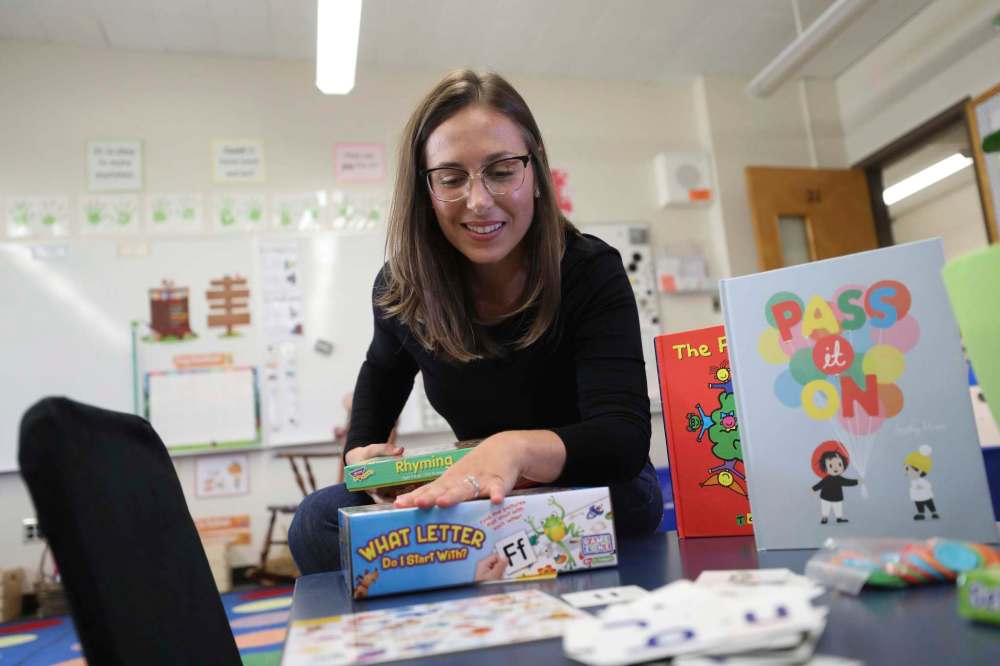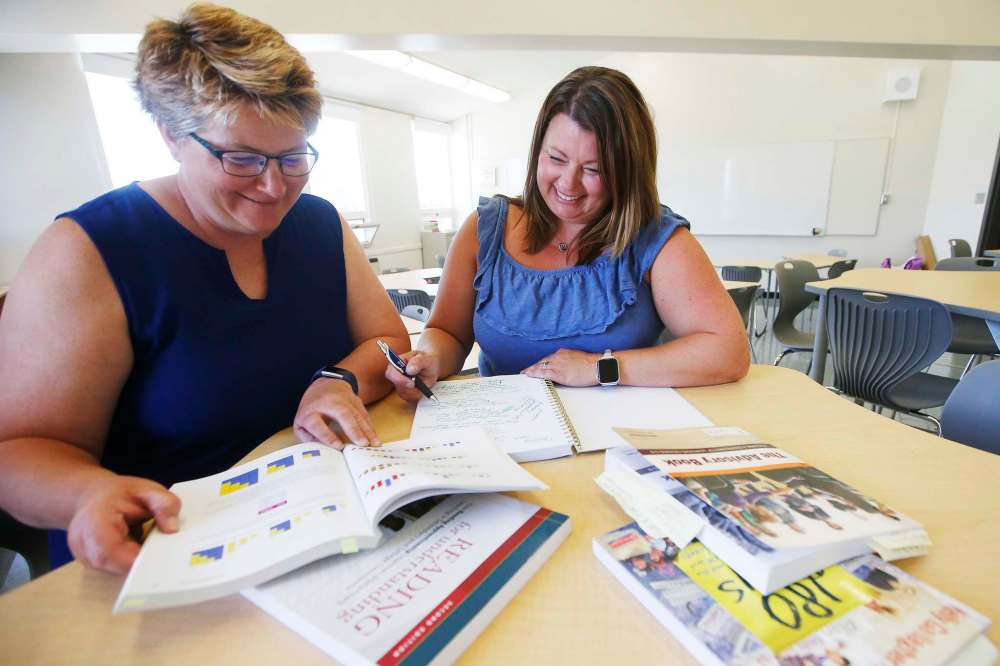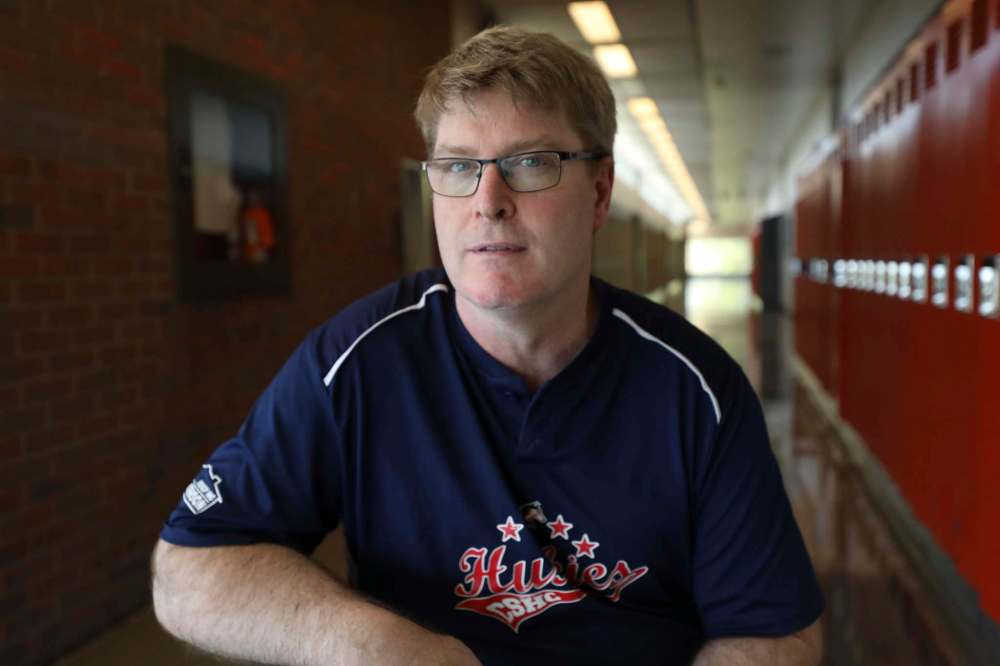Class acts For teachers at every grade level, much planning and preparation lead up to the first day of school
Read this article for free:
or
Already have an account? Log in here »
To continue reading, please subscribe:
Monthly Digital Subscription
$0 for the first 4 weeks*
- Enjoy unlimited reading on winnipegfreepress.com
- Read the E-Edition, our digital replica newspaper
- Access News Break, our award-winning app
- Play interactive puzzles
*No charge for 4 weeks then price increases to the regular rate of $19.00 plus GST every four weeks. Offer available to new and qualified returning subscribers only. Cancel any time.
Monthly Digital Subscription
$4.75/week*
- Enjoy unlimited reading on winnipegfreepress.com
- Read the E-Edition, our digital replica newspaper
- Access News Break, our award-winning app
- Play interactive puzzles
*Billed as $19 plus GST every four weeks. Cancel any time.
To continue reading, please subscribe:
Add Free Press access to your Brandon Sun subscription for only an additional
$1 for the first 4 weeks*
*Your next subscription payment will increase by $1.00 and you will be charged $16.99 plus GST for four weeks. After four weeks, your payment will increase to $23.99 plus GST every four weeks.
Read unlimited articles for free today:
or
Already have an account? Log in here »
Hey there, time traveller!
This article was published 30/08/2019 (2299 days ago), so information in it may no longer be current.
The floors are gleaming with fresh wax, the desks are arranged just so and the classroom library is organized alphabetically, for the time being.
Transition tips for kids
The beginning of the school year can stir up strong emotions. Some students are excited about returning to the classroom, while others are filled with stress and anxiety. The way those emotions are addressed at home can set the tone for the rest of the year.
The beginning of the school year can stir up strong emotions. Some students are excited about returning to the classroom, while others are filled with stress and anxiety. The way those emotions are addressed at home can set the tone for the rest of the year.
“It’s important for parents to be thinking about how to help their kids gradually make that transition,” says Kari Deschambault, a mental-health clinician with Kidthink Children’s Mental Health Centre in Winnipeg.
Kidthink opened in early 2019 and provides mental illness treatment and outreach services for kids aged 12 and under.
“Seventy per cent of mental illness has its onset in early childhood and adolescence, so that’s why it’s important to focus on those earlier age groups,” she says.
Below are some practical tips from Deschambault for prioritizing mental wellbeing during a particularly stressful time of year:
Return to regular programming early
Summer vacation usually means a departure from structured daily routines. Since kids thrive on predictability, Deschambault suggests getting back to a regular sleep and meal schedule one to two weeks before the first day of school.
Strive for a balanced schedule
School and extra-curricular activities often go hand-in-hand. When signing up for piano lessons and sports teams, leave room on the calendar for downtime. “Unstructured play is usually how kids de-stress,” she says. “If they’re involved in too many activities they can get stressed and fatigued and that can really contribute to a deterioration in mental health.”
Make room for mental health
Give kids space to talk about their thoughts and feelings about heading back to school. If they’re anxious, visiting the schoolyard or meeting with the teacher before classes start can help calm those nerves.
Encourage a growth mindset
Focusing on grades can take away from a student’s enjoyment of school. Instead, try praising their work effort, problem-solving and creativity. It’s also important to help kids understand that failure is a natural part of the growth and learning process.
Practise facing fears
Kids aren’t immune to social anxiety. If your child is worried about making friends and meeting new people, it can help to remind them that their classmates are likely feeling the same way. Deschambault says the only way to overcome this and other kinds of anxiety is to face fears head on — the outcome is never as bad as what’s been imagined and avoidance only leads to more anxiety.
— Eva Wasney
This “calm before the storm” scene is familiar to the thousands of teachers across Manitoba who have spent the last two weeks in the classroom getting ready for the coming school year.
Aside from mandatory staff meetings, the pre-school prep work is unpaid. Despite this, it’s an important part of the back-to-work routine for many teachers.
The Free Press stopped by three classrooms in Winnipeg recently to find out how teachers prepare themselves and their classrooms for first day of school in September.

Amanda Battaglia
Grade 1, Lord Nelson School
It takes a lot of work to prepare an early years classroom for a new school year — arguably more than any other grade level.
Like many teachers, Amanda Battaglia’s room was a blank slate when she returned to school a week and a half ago. All the tables and chairs were in the hallway and the walls had been stripped bare so custodial staff could do a deep cleaning over the summer.
When she started rebuilding her classroom she had two things on her mind: accessibility and flexibility.
“I want students to feel comfortable and be able to use whatever they need whenever they need,” she says.
In a few short days, Battaglia will be the only adult in a room of 21 six- and seven-year-olds. That means toys, games, learning tools and books need to be available at all times and organized in a way that small humans can reach them without assistance.
She has created a cosy reading nook in one corner and a relaxation station in another, where students who are feeling overwhelmed or overstimulated can sit under a faux palm leaf and play with calming sensory toys. Real plants are scattered throughout the room and there are tables of different heights and chairs designed for rocking, sitting and lounging.
There is a lot of freedom built into the space — freedom to move, freedom to play and freedom to inquire.
One of Battaglia’s favourite features is the large bank of windows on the north side of the room.
“A lot of questions have come about just because we have been looking out the window. I want students to know that there is so much more than just these four walls.”– Amanda Battaglia
“A lot of questions have come about just because we have been looking out the window,” she says. “I want students to know that there is so much more than just these four walls.”
The first week of school will also feature a new form of freedom for her Grade 1 students, who will be experiencing recess for the first time. To make sure the breaks run smoothly, Battaglia and her colleagues have to lay out the playground rules as explicitly as they can.
“We do a tour outside and show them how to use the slide and how to wait their turn,” she says.
Those lessons about sharing, kindness, manners and basic social norms also apply within the classroom and are a major part of the curriculum during the first week back.
Battaglia seems to have all of her bases covered, but that’s probably because she never really stops thinking about work. When she’s shopping, spending time with friends or even just taking a walk in the park she’s listening and looking for things she can bring back to her classroom.
“It’s always in the back of my mind,” she says. “But I know that it is really important to re-energize myself and take a little bit of a step back.”
She has also spent a lot of her own time in the school over the summer — in July she was busy meeting with colleagues after the last year ended and now, in the waning days of August, she is busy setting up her classroom before the new year is set to begin.
Battaglia is in her sixth year of teaching and her second at Lord Nelson School in the Shaughnessy Park neighbourhood. She knows from past experience that the transition from summer holidays to working full-time will be a lot smoother if she remembers to take some time for herself. Although, that’s easier said than done.
“It’s hard because I enjoy preparing activities for the kids so I tend to use (break) time to set up, which is probably when I should be using that time to take a moment and take a breath and use the bathroom,” she says. “I have to remember it’s myself that keeps this classroom going.”

Kimberley Adair-Gagnon
Grades 7-8, Windsor Park Collegiate
Even though Kimberley Adair-Gagnon is headed into her 20th year of teaching, it’s been a while since she’s had her own classroom.
For the last three years she worked as an instructional support teacher with the Louis Riel School Division, helping out at schools all over southeast Winnipeg. This year, she’s one of three teachers tasked with starting a new junior high program at Windsor Park Collegiate.
“I almost feel like a new teacher again,” Adair-Gagnon says.
Next week, about 75 students in grades 7 and 8 will be taking over one wing of the high school.
The new program was born out of necessity to help deal with chronic over-enrolment at École Sage Creek School — according to a 2018 Free Press article, the school was expected to be over capacity by 140 students last September. To address the problem, the division has decided to move the school’s junior high population to Windsor Park and Collège Béliveau, for the French-immersion students.
Adair-Gagnon is excited about the fresh start.
“This area was not an often used space in the school before, they were able to totally redesign it to make it fit a middle years program,” she says.
Her new classroom has bright white walls and plenty of natural light. It is one of three rooms that surrounds a central common area that will soon be filled with couches and space for group work.
On Aug. 20, just a few hours after she and her colleagues were able to get into the school for the first time during the summer, Adair-Gagnon already had a few things up on the walls and was brainstorming ways to make her students feel at home.
“Things that are going to become routine and support learning in the classroom every day, that warrants wall space for me,” she says, looking thoughtfully around the room. “I want my students to see themselves reflected in the space… I don’t want to take over the space with my stuff or my agenda.”
She hopes to achieve that with bulletin boards reserved for student work and questions. There is also a graffiti wall and a giant black-and-white line drawing of a fish where students can colour whenever they need to de-stress. Adair-Gagnon is quite literally creating a blank canvas for her students to imprint upon.
Even though she planned on spending a few hours at the school organizing her room and lesson planning every day for the last two weeks of her vacation, Adair-Gagnon doesn’t view the prep work as a burden. Quite the opposite, actually.
Even though she planned on spending a few hours at the school organizing her room and lesson planning every day for the last two weeks of her vacation, Adair-Gagnon doesn’t view the prep work as a burden. Quite the opposite, actually.
Like Battaglia, Adair-Gagnon has also been thinking about school all summer. She spent most of July working on her masters degree and led a professional development workshop for other teachers earlier this month.
“I was just so ready to take all of that learning and consolidate it and come back to the classroom,” she says.
As with any extended vacation, the desire to get back to work has also started to creep in.
“You start getting the itch to get back into routine, and of course it’s really motivating to come and start with a clean slate to set up your classroom for this new, eager group of kids that are going to be starting soon,” she says, adding that she probably won’t sleep much the night before the first day of school.
Adair-Gagnon wasn’t the only teacher in the school when the Free Press visited; her colleague Anita Fedoruk was two classrooms over, unpacking boxes and getting her own room ready. The prep time also gives teachers a valuable opportunity to connect with each other sans students.
“The beautiful thing is that we all bring a different expertise to the program,” Adair-Gagnon says. “The more that we can work together, the better it is for the students.”

Stephen Lewis
Grades 9-12, Collège Sturgeon Heights Collegiate
As the head of the English department at Collège Sturgeon Heights Collegiate, Stephen Lewis has to plan well beyond his own syllabus.
There are some new teachers joining the department this fall and Lewis has spent the last two months creating welcome binders to help them get ready for the year ahead.
“Because I’m a leader in this group, I want to make sure the teachers are as comfortable as possible and have the resources they need,” he says. “That makes me feel better because then I can start looking at what I need to do.”
Within his own room, he has to make sure the space is arranged in a way that makes sense for all of the grade levels he teaches. He has the desks set up in a way that’s conducive to group work and has designated bulletin boards for work from each of his classes.
“I like to have them put their own work out there so people can talk about it or ask questions, and it’s also a way of helping them feel valued,” he says.
Between reading essays aloud and offering up personal interpretations on a piece of literature, there’s a lot of vulnerability in a high school English class. Because of this, the decor in Lewis’ room comes secondary to the social expectations of the space.
He tackles this in the first week of classes by bringing his students in on the planning process. As a group, they talk about how to foster respect and trust and how to disagree with one another in a positive way — a skill that will come in handy for the students headed off to university next year.
“It’s OK to disagree and it doesn’t mean there’s some dislike of the person,” Lewis explains. “There’s different ways of dealing with disagreements so you’re being respectful and able to support the person’s thinking.”
“I’ve been teaching for 25 years and I’m trying to keep up with the times and adapt, and I realize kids really develop and enjoy their own books.”– Stephen Lewis
His students also get a say in what the curriculum will look like. While he likes to include classics like Shakespeare and Of Mice and Men on the reading list, he also encourages students to pick their own books to analyze.
“I’ve been teaching for 25 years and I’m trying to keep up with the times and adapt, and I realize kids really develop and enjoy their own books,” he says.
“Any piece of literature that you study with them is going to be different because of their various backgrounds and experiences… It’s always exciting to see their processes and help them get to their own meaning through inquiry.”
The results of this kind of inquiry is on display above a bank of cabinets in one corner of Lewis’ room. The colourful paintings, woodworking projects and origami sculptures were all made by past students in response to a reading assignment. They serve as inspiration for future students and a reminder for Lewis of the creative potential of young minds.
As a veteran teacher, Lewis has had his fair share of first days of school. However, dealing with the onslaught of daily classes and meetings after two months off doesn’t get any easier.
“You kind of hit it full-bore,” he says. “It gets very busy, which is good, but it just takes some getting used to coming out of the summer.”
Despite the challenges of transitioning back to work, Lewis says the break is a vital part of the annual teaching cycle.
“It takes a while to decompress and make sure you’re attending to different personal needs that were neglected during the school year because it’s so busy for every level of teacher, and then it’s important to take the time to refine your practice,” he says.
eva.wasney@freepress.mb.ca
Twitter: @evawasney

Eva Wasney has been a reporter with the Free Press Arts & Life department since 2019. Read more about Eva.
Every piece of reporting Eva produces is reviewed by an editing team before it is posted online or published in print — part of the Free Press‘s tradition, since 1872, of producing reliable independent journalism. Read more about Free Press’s history and mandate, and learn how our newsroom operates.
Our newsroom depends on a growing audience of readers to power our journalism. If you are not a paid reader, please consider becoming a subscriber.
Our newsroom depends on its audience of readers to power our journalism. Thank you for your support.












